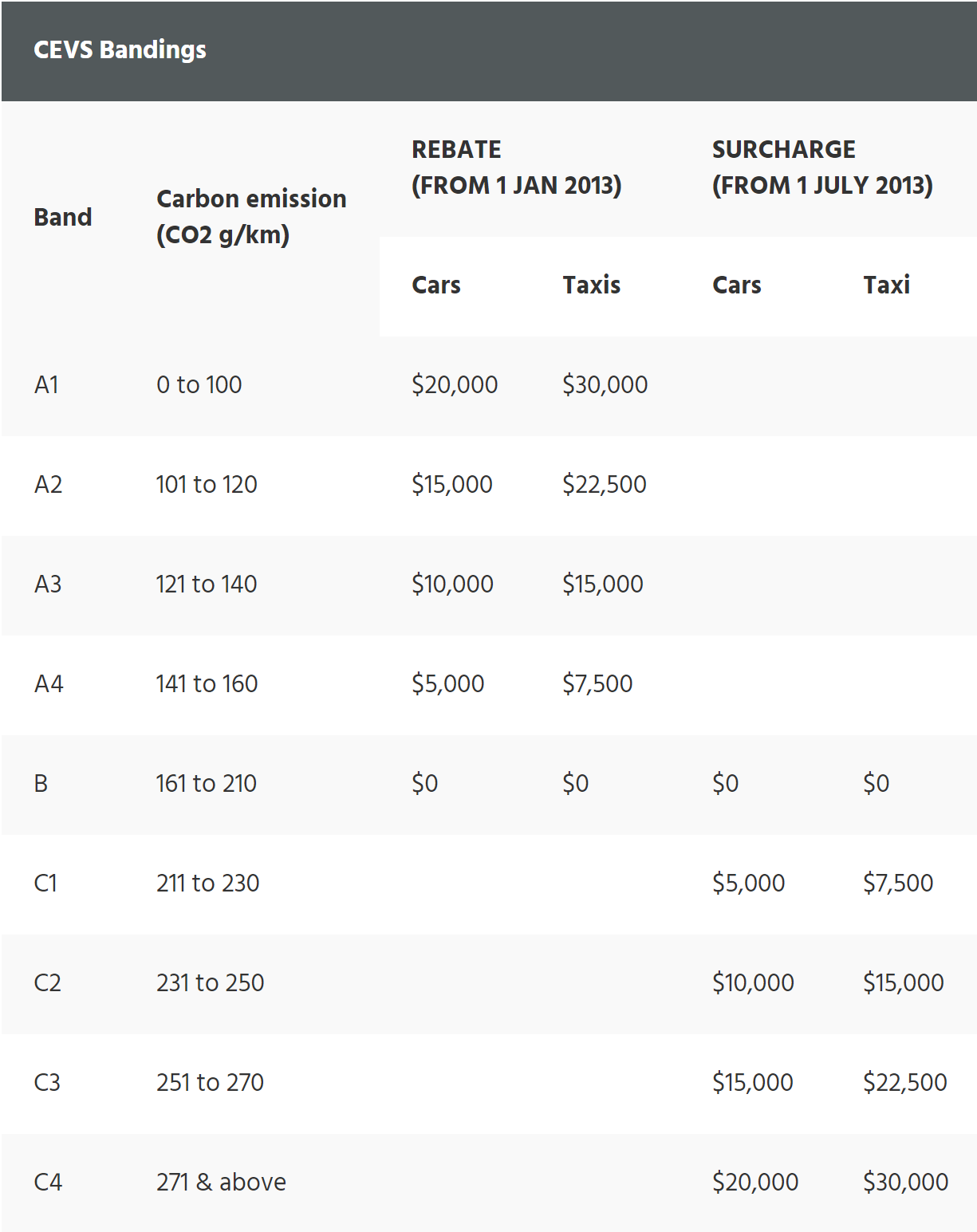New Carbon Emissions-Based Vehicle Scheme (CEVS) from 1 January 2013
New scheme incentivises buyers to shift to low emission models
As announced by the Minister for Finance during the 2012 Budget Statement and the Minister for Transport during the Committee of Supply 2012, a new Carbon Emissions-Based Vehicle Scheme (CEVS) will be implemented in 2013. The CEVS will apply to all new cars, taxis and newly imported used cars registered with effect from 1 January 2013.
The CEVS adopts a broader outcome-based approach that takes into consideration vehicles’ carbon emissions and fuel efficiency to encourage consumers to shift to low emission models. This new scheme will replace the existing Green Vehicle Rebate (GVR)1 scheme for cars and taxis based on specific engine types when the GVR scheme expires on 31 December 2012.
Under CEVS, all new car and imported used cars registered from 1 January 2013 with low carbon emissions of less than or equal to 160g carbon emissions per kilometre (CO2/km ), will qualify for significant rebates of between $5,000 and $20,000 which will be given as an offset against the vehicle’s Additional Registration Fee (ARF) payable. Cars with high carbon emissions equal to or more than 211g CO2/km, will incur a corresponding registration surcharge between $5,000 and $20,000.
Taxis generally clock higher mileage than cars. To encourage taxi companies to adopt lower emission models for their fleet, the CEVS rebate and registration surcharge for taxis is set at 50 per cent higher compared to cars, between $7,500 and $30,000.
The CEVS rebates will be implemented from 1 January 2013. The surcharges will only take effect 6 months later, from 1 July 2013 to give consumers and the motor industry more time to adjust.
Details of CEVS bandings are as follows:
As non Euro V-compliant diesel models emit significantly more fine particulate matter, they will not enjoy the ARF rebates under CEVS even if they fall within the rebate emission bands. However if these models fall within the surcharge bands, the appropriate CEVS surcharge will still apply.
The CEVS will be applicable till 31 December 2014. The scheme will be reviewed, taking into consideration its impact on motorists’ purchasing decision, technological advances and the progress in Singapore’s overall mitigation efforts on climate change.
The current GVR scheme for commercial vehicles, buses and motorcycles will be extended for another 2 years to 31 December 2014 as LTA reviews how to better encourage the shift to low carbon emission models in these vehicle categories.
Enhancements to the Fuel Economy Labelling Scheme (FELS)
To assist car buyers make informed decisions, the CO2/km performance data for each car model will be provided on mandatory information labels at car showrooms. LTA will also set up a new FELS online database and online fuel cost calculator so that buyers can easily access and compare the carbon emissions and fuel efficiency performance data across car models. These changes will be made progressively after LTA takes over the administration of the Fuel Economy Labelling Scheme (FELS) from NEA around mid 2012. More details on FELS will be made available then.
Footnotes:
1The Green Vehicle Rebate (GVR) scheme was introduced in 2001 to encourage the take up of green vehicles. Electric, petrol-electric hybrid, compressed natural gas (CNG) and bi-fuel (CNG/petrol) vehicles are given a rebate of up to 40 per cent of the vehicle’s Open Market Value (OMV) which is offset against the vehicle’s Additional Registration Fee (ARF).
2Carbon emissions refer to the release of carbon dioxide from the use of a vehicle, and provide a good indicator of the amount of fuel the vehicle uses. The g CO2 /km is a measure that quantifies the weight of carbon dioxide (CO2) released for every kilometre that the vehicle is driven i.e. the vehicle’s fuel efficiency. The more CO2 released over the same distance means more fuel is being used.
3CEVS rebate is subject to a minimum ARF payable of $5,000, as cars that have relatively low ARF payable and are already fuel-efficient do not need to be further incentivised. </u>
Source: Land Transport Authority


